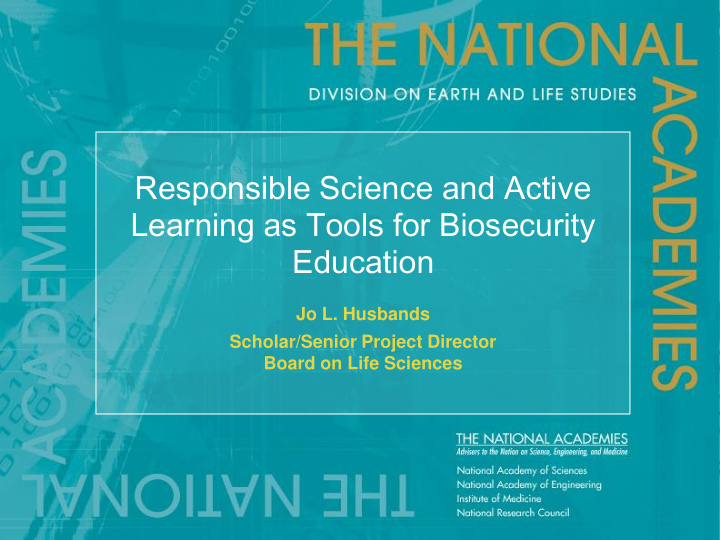



Responsible Science and Active Learning as Tools for Biosecurity Education Jo L. Husbands Scholar/Senior Project Director Board on Life Sciences
Three Assumptions • Education as the foundation for biorisk management/biosecurity • Power of framing issues as responsible conduct of science • Contributions of active learning to effective education
Education Institutes • Goal – Create networks of faculty • Context – general life sciences community • Framing – dual use as part of responsible conduct • Model – NAS Summer Institutes on Undergraduate Biology Education – Residential – Hands-on experience; Work in teams – Emphasis on active learning – Commitment to apply in home institutions – Follow-up
Educational Institutes – Small grant competition enables participants to apply their knowledge in home institutions – Reunion and assessment – Report on first Institute produced in June 2013
Education Institutes • Two Institutes in the MENA (2012 and 2014) – Partnering with Bibliotheca Alexandrina and TWAS – Faculty from Algeria, Egypt, Jordan, Lebanon, Libya, Morocco, and Yemen • Institute in South/Southeast Asia (2013) – Partnering with Academy of Sciences Malaysia – Faculty from India, Malaysia, and Pakistan
Two Lessons: #1 Framing the issues as Responsible Science: Makes concepts such as biosecurity and dual use relevant and more readily accepted when presented as part of the larger social responsibility of science; Is compatible with more security-focused activities for specialized, more directly affected audiences; Facilitates reaching wide range of scientists, who are part of many stakeholders (e.g., academia, industry, public health); and Can complement the existing legal and regulatory structure and provide a basis for discussing additional measures or changes in practices.
Lesson #2 Using active learning techniques: • Is readily accepted as an innovative and effective approach to teaching (capacity building) • Is being successfully implemented by participants in their home institutions (sustainability) – Works even for those from hierarchical academic systems and large universities – Provides an opportunity to share their experiences and lessons learned
THANK YOU! For more information: Jo L. Husbands jhusband@nas.edu All NAS reports available as free pdfs at www.nap.edu
Recommend
More recommend